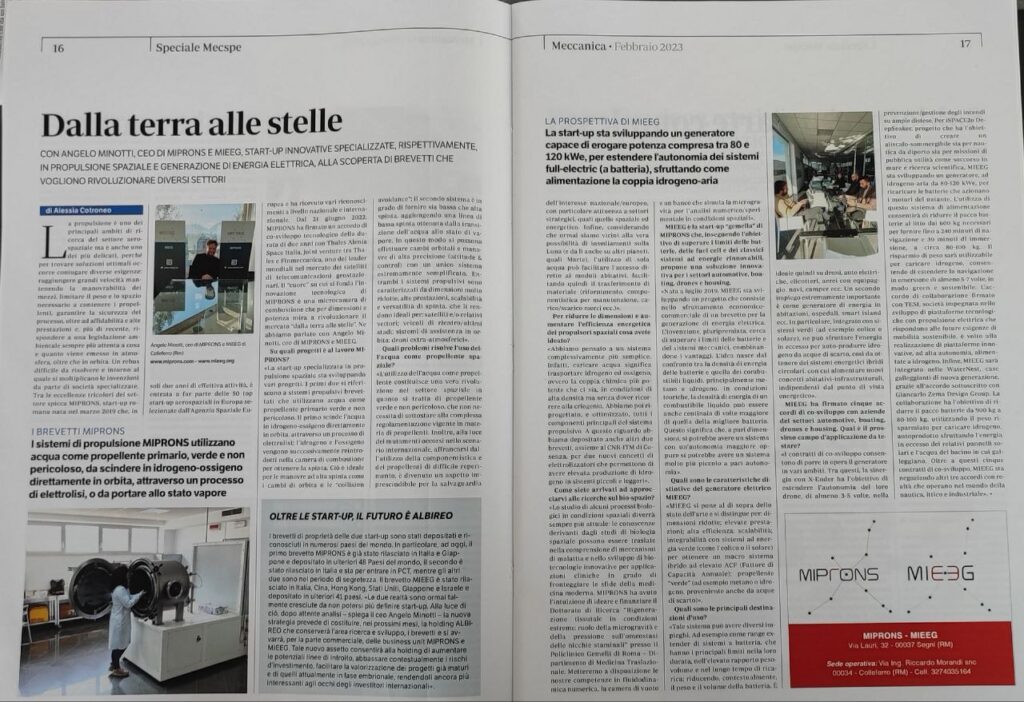Angelo Minotti, CEO and founder of MIPRONS, was interviewed by Meccanica magazine in the February issue.

MIPRONS, a startup founded in 2019, in just two years of effective activity, has become part of the 50 top aerospace startups in Europe selected by the European Space Agency and has received various awards at national and international levels. Since June 21, 2022, MIPRONS has signed a two-year co-development agreement with Thales and Finmeccanica, one of the world leaders in the market of geostationary telecommunications satellites. The “heart” on which MIPRONS’ technological innovation is based is a micro-combustion chamber that aims to revolutionize the market “from the earth to the stars”.
What projects is MIPRONS working on?
“The start-up specialized in space propulsion is developing various projects. The first two refer to patented propulsion systems that use water as a green and non-hazardous primary propellant. The first one splits water into hydrogen-oxygen directly in orbit, through an electrolysis process: hydrogen and oxygen are then reintroduced into the combustion chamber to obtain thrust. This is ideal for high-thrust maneuvers such as orbit changes or “collision avoidance”. The second system can provide both low and high thrust, adding a low thrust line obtained from the transition of water to steam. In this way it is possible to perform orbital changes and high-precision maneuvers (attitude & control) with a single extremely simplified system. Both propulsion systems are characterized by very small dimensions, high performance, scalability and thrust versatility, which make them ideal for satellites and/or related carriers; re-entry/last stage vehicles; in-orbit assistance systems; extra-atmospheric drones”.
What problems does the use of water as a space propellant solve?
“Using water as a space propellant is a real revolution in the space sector, as it is a green and non-hazardous propellant, which does not need to comply with the complex regulations in force on propellants. Moreover, in light of the changes that have occurred in the international scenario, freeing oneself from the use of components and propellants that are difficult to obtain, has become an essential aspect for the safeguarding of the national/European interest, with particular relevance to strategic sectors, such as space and energy. Finally, considering that we are now close to the real possibility of settlements on the Moon (and from there also on other planets, such as Mars), the use of only water can facilitate direct access to the living modules, thus facilitating the transfer of material (refueling, maintenance components, loading/unloading goods, etc.)”.
To reduce the size and increase the energy efficiency of space thrusters what have you devised?
“We thought of an overall simpler system. Loading water means transporting hydrogen and oxygen, i.e. the most powerful chemical pair there is, in conditions of high density but without having to resort to cryogenics. We then redesigned and optimized all the main components of the propulsion system. In this regard, we have also filed two other patents, together with CNR-ITM of Cosenza, for two new concepts of electrolyzers that allow having high production of hydrogen in small and light systems”.
How did you come to approach bio-space research?
“The study of some biological processes in space conditions will become increasingly relevant: the knowledge derived from space biology studies can be translated into the understanding of disease mechanisms and the development of innovative biotechnologies for clinical applications that can cope with the challenges of modern medicine. MIPRONS had the intuition to conceive and finance the Ph.D. “Tissue regeneration in extreme conditions: Role of microgravity and pressure on the homeostasis of stem niches” at the Policlinico Gemelli in Rome – Department of Translational Medicine. We will make available our expertise in numerical fluid dynamics, the vacuum chamber, and a bench that simulates microgravity for numerical/experimental analysis in space conditions”.


 Copyright 2023 All rights reserved.
Copyright 2023 All rights reserved.